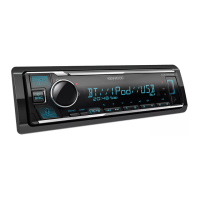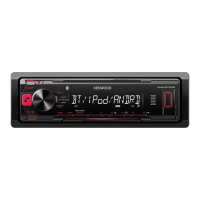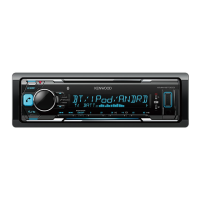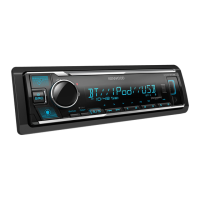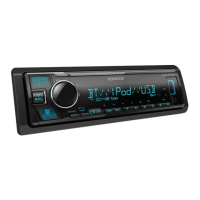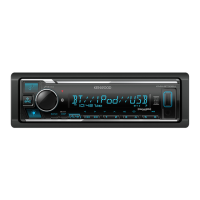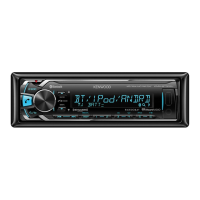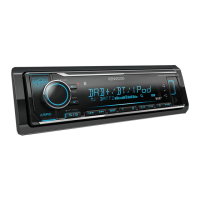What does “NO INFO” mean on my Kenwood Receiver?
- JJade Cruz DDSSep 14, 2025
If your Kenwood Receiver displays “NO INFO” or “NO DATA”, the Bluetooth device cannot get the contact information.
What does “NO INFO” mean on my Kenwood Receiver?
If your Kenwood Receiver displays “NO INFO” or “NO DATA”, the Bluetooth device cannot get the contact information.
How to improve radio reception on Kenwood KMM-BT304 Receiver?
To improve poor radio reception on your Kenwood Receiver, ensure the antenna is firmly connected.
What to do if Kenwood Receiver doesn't detect Bluetooth device?
If your Kenwood Receiver isn't detecting any Bluetooth devices, try searching from the Bluetooth device again. If that doesn't work, reset the unit.
Why is Bluetooth audio skipping on my Kenwood Receiver?
If the sound is being interrupted or skipping during Bluetooth playback on your Kenwood Receiver, try reducing the distance between the unit and the Bluetooth audio player. You can also try turning the unit off and on again. Also, check for other Bluetooth devices that might be trying to connect to the unit.
What does “SWITCHING NG” mean on my Kenwood Receiver?
If your Kenwood Receiver displays “SWITCHING NG”, the connected phones might not support the phone switching feature.
Why does “LOADING” appear on my Kenwood Receiver?
If “LOADING” appears when you enter search mode on your Kenwood Receiver, the unit is still preparing the iPod/iPhone music list. It may take some time to load, so try again later.
How to enable playback at [BROWSE MODE] on Kenwood KMM-BT304 Receiver?
To enable playback in [BROWSE MODE] on your Kenwood Receiver, ensure that the KENWOOD MUSIC PLAY APP is installed on the Android device. Also, reconnect the Android device and select the appropriate control mode. If problems persist, the connected Android device might not support [BROWSE MODE].
What does “UNRESPONSIVE DEVICE” mean on my Kenwood KMM-BT304 Receiver?
If your Kenwood Receiver displays “UNRESPONSIVE DEVICE”, make sure the device is not malfunctioning and reattach the device.
Why does “NO DEVICE” or “READING” keep flashing on my Kenwood KMM-BT304?
If your Kenwood Receiver displays “NO DEVICE” or “READING” keeps flashing, switch off the developer options on the Android device and reconnect the Android device. If this does not solve the problem, the connected Android device does not support [BROWSE MODE].
What does “iPod ERROR” mean on my Kenwood KMM-BT304 Receiver?
If your Kenwood Receiver displays “iPod ERROR”, try reconnecting the iPod or resetting it.
Read manual, observe warnings and cautions for proper use.
Do not operate functions that distract from safe driving.
Adjust volume for external awareness, lower volume for digital sources.
Avoid distractions, ensure data backup, prevent short circuits.
Guide on interpreting explanations using buttons and references.
Identifies main unit controls like buttons, knobs, and display.
Instructions for removing and installing the detachable faceplate.
Steps to reset the unit, typically after detaching the faceplate.
Select display language and disable the demonstration mode on first use.
Configure clock format, time, date format, and date settings.
Access FUNCTION menu to set up basic operational parameters.
Configure preout, display illumination colors, and tuner preset types.
Manage key beep, enable/disable Spotify and AUX sources.
Update firmware and reset unit settings to factory defaults.
Enable or disable the clock display when the unit is turned off.
Select 2-way or 3-way crossover based on speaker configuration.
Search for stations, store, select, and access radio settings.
Use SEEK, AUTO1, AUTO2, MANUAL modes to find stations. Store and select stations.
Access FUNCTION menu for various radio operational settings.
Configure Local Seek, Auto Memory, Mono Set, News Set, Regional, AF Set, TI, PTY Search, Time Sync.
Lists speech and music categories for PTY search functionality.
Connect USB devices/iPod/iPhone/Android; playback starts automatically.
Details on USB input terminal and required accessories for device connection.
Controls for playback, pause, skip, repeat, and random play for connected devices.
Choose device control mode and select music playback drive.
Listen to TuneIn Radio and search files using Quick, Skip, and Alphabet methods.
Settings for controlling the unit via the KENWOOD Remote application.
Connect an external audio player and select AUX source for playback.
Set a custom name for the AUX input source.
Install app, enable source, connect device, and control Spotify playback.
Save or remove songs from "Your Music" or "Your Library" on Spotify.
Browse and select songs or stations from the Spotify service.
Lists supported Bluetooth profiles (HFP, A2DP, etc.) and codecs (SBC, AAC).
Instructions for connecting the external microphone and adjusting its angle.
Steps to search, select, and pair a Bluetooth device with the unit.
Auto-pairing feature when connecting compatible devices via USB.
Manage incoming calls, answer/reject, and use auto-answer feature.
Handle multiple calls, switch between calls, and adjust call volume.
Adjust microphone gain, noise reduction, and echo cancellation for clearer calls.
Initiate calls from call history, phonebook, or by dialing.
Access phonebook, dial numbers, and use voice commands for calls.
Use phone's voice recognition and store contacts in memory buttons.
Manage BT mode, device selection, delete devices, edit PIN, reconnect, auto-pairing, initialize.
Verify connectivity of supported Bluetooth profiles between device and unit.
Play audio from a Bluetooth audio player, including controls and file selection.
Use Remote App with iPhone/iPod or Android via Bluetooth.
Check connection status for iOS and Android devices.
Listen to music from iPhone/iPod via Bluetooth.
Stream Spotify music from iPhone/iPod/Android via Bluetooth.
Adjust subwoofer level and manually set equalizer frequencies.
Adjust subwoofer output and manually set equalizer frequencies.
Configure Bass Extend, Q Factor, Preset EQ, and Bass Boost.
Adjust Loudness, Subwoofer, Fader, Balance, Volume Offset, and Sound Effect.
Overview of speaker size selection and crossover frequency/slope settings.
Fine-tune speaker size, crossover frequency, slope, phase, and gain for 2-way systems.
Fine-tune speaker size, crossover frequency, slope, phase, and gain for 3-way systems.
Compensate speaker delays for optimal soundstaging based on listener position.
Configure car type and rear speaker location for accurate DTA adjustments.
Map display zones (ZONE 1, ZONE 2, ALL ZONE) to units.
Set dimmer ON/OFF times and adjust brightness levels for display zones.
Choose automatic or single scrolling for text information on the display.
Fixes for sound issues, wiring errors, unit malfunctions, and poor radio reception.
Solutions for USB/iPod connection errors like "NO DEVICE" or "UNSUPPORTED DEVICE".
Resolve Android playback issues, Spotify connection problems, and app errors.
Address Bluetooth detection failures, pairing issues, echo, and sound quality problems.
Resolve "DEVICE FULL", "N/A VOICE TAG", "NOT SUPPORT", and "SWITCHING NG" errors.
Safety warnings for power supply, wiring, and preventing short circuits.
Safety warnings for power supply, wiring, and preventing short circuits.
Identify installation components and follow basic steps for unit installation.
Steps to detach the faceplate and remove the unit from the dashboard.
Guide for wiring connections, including ISO connector pinouts and functions.
Diagrams for connecting microphone and audio output terminals.
Cleaning instructions and sources for firmware updates and compatibility data.
Details on supported audio file formats and USB device requirements.
Compatibility information for iPod/iPhone, Android, Spotify, and Bluetooth devices.
Explains how the display information cycles through different data types.
Detailed specs for tuner frequency, sensitivity, USB standard, and file system.
Technical specs for Bluetooth version, range, profiles, output power, and audio settings.
Specs for auxiliary input, operating voltage, temperature range, and dimensions.
| DIN size | 1 DIN |
|---|---|
| Impedance | 600 Ω |
| Clock mode | 24h |
| Output power | 20 W |
| Product color | Black |
| Ready for iPod | Yes |
| Volume control | Rotary |
| Frequency range | 20 - 20000 Hz |
| Disc types supported | No |
| Audio output channels | 4.0 channels |
| Equalizer bands quantity | 13 |
| Maximum power per channel | 50 W |
| Audio formats supported | AAC, FLAC, MP3, WAV, WMA |
| Display type | LCD |
| Display digits | 13 digits |
| Illumination color | - |
| Display number of lines | 1.5 lines |
| Number of OSD languages | 3 |
| On Screen Display (OSD) languages | ENG, ESP, RUS |
| USB version | 2.0 |
| Bluetooth range | 10 m |
| Bluetooth version | 3.0+HS |
| USB port position | Front |
| Bluetooth profiles | A2DP, AVRCP, HFP, PBAP, SPP, SSP |
| USB ports quantity | 1 |
| Bluetooth functions | Audiostreaming, Handsfree calling |
| FM band range | 0.00003 - 0.015 MHz |
| LW band range | 153 - 279 kHz |
| Supported radio bands | AM, FM, LW, MW |
| Preset stations quantity | 24 |
| Hands-free calling | Keep your hands on wheel with Bluetooth™ Hands-free calling. After pairing your compatible Bluetooth mobile phone to your TomTom GPS, you’ll be able to see incoming call information, make and answer calls, and talk hands-free through your device. You’ll e |
| Operating temperature (T-T) | -10 - 60 °C |
| Depth | 100 mm |
|---|---|
| Width | 182 mm |
| Height | 53 mm |
| Weight | 600 g |
